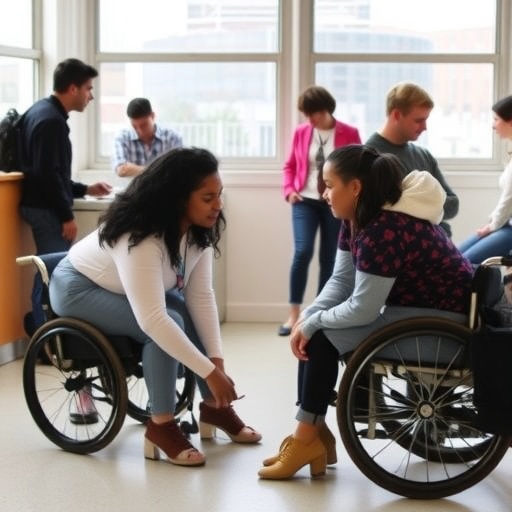In a thought-provoking exploration published in the academic journal High Educ, researcher Philipp Angerhausen sheds light on the intricate realities faced by disabled students in German higher education. This work illuminates the multifaceted and often hidden challenges that these students navigate in pursuit of their academic goals. By adopting an intersectional perspective, Angerhausen provides a nuanced analysis that goes beyond superficial assumptions about disability, recognizing how various aspects of identity—such as race, gender, and socioeconomic status—interact to complicate experiences within the educational landscape.
The research underscores that the challenges encountered by disabled students are not monolithic but rather a tapestry woven from personal narratives, social contexts, and institutional policies. Each student’s journey is uniquely shaped by their background, personal circumstances, and the environments they inhabit. Angerhausen emphasizes the importance of understanding these variables in order to create more inclusive practices and policies within academic institutions.
The findings are startling, drawing attention to systemic barriers that persist, despite progress in awareness and disability rights. For many disabled students, higher education represents a battleground where they are often required to prove their legitimacy and worthiness, in addition to meeting academic expectations. This additional layer of scrutiny can lead to heightened stress, anxiety, and feelings of isolation. Angerhausen’s analysis reveals how this pressure not only affects academic performance but can also alter students’ self-perception and future aspirations.
Moreover, Angerhausen identifies the role of professors and university staff in shaping the experiences of disabled students. The study suggests that educators play a pivotal role in either perpetuating exclusionary practices or fostering an environment of support and understanding. According to Angerhausen, training for faculty and staff on inclusive education practices is not merely beneficial; it’s essential to dismantle the prejudices and misconceptions that often underlie interactions with disabled students.
The intersectional perspective also emphasizes that disabled students come from varied backgrounds, each with its own set of experiences and challenges. Minority students, for instance, may face compounded discrimination that can further hinder their ability to succeed in higher education. Angerhausen’s examination of these dynamics calls for more tailored support systems that acknowledge and address these complexities, rather than adopting a one-size-fits-all approach.
In addition to discussing the barriers within academic frameworks, Angerhausen also delves into the social dynamics that play out on college campuses. The stigma surrounding disability often leads to social exclusion, where disabled students may feel marginalized not just academically but socially as well. This isolation can diminish the college experience, which is intrinsically tied to networking and social engagement. The work highlights the vital role that peer support and community-building initiatives can play in bridging these gaps.
Moreover, the study acknowledges the advancements made in technology and resources that can alleviate some of these barriers. Assistive technologies have revolutionized the educational experiences of many disabled students, allowing for increased accessibility and learning opportunities. However, Angerhausen warns against complacency, insisting that institutions must continually evaluate and improve these resources to ensure they are effective and equitable for all students.
One of the most resonant findings of the research is the emotional toll that navigating these challenges can take on disabled students. Mental health issues, including anxiety and depression, are prevalent among these individuals, often exacerbated by the systemic barriers they face. Angerhausen advocates for mental health resources that are specifically tailored to the needs of disabled students, highlighting the need for institutions to recognize the interplay between disability and mental health in their support systems.
In a realm where universities often strive for diversity and inclusion, Angerhausen’s research serves as a critical reminder that numbers alone do not equate to meaningful progress. The representation of disabled students in higher education is important, but their experiences must be understood and addressed if genuine inclusion is to be realized. Angerhausen urges educational institutions to engage in a deeper dialogue about the lived experiences of disabled students as they strategize for inclusivity.
Additionally, the research discusses the importance of policy-making at institutional and governmental levels. Angerhausen argues that policy reform must prioritize the voices of disabled students, ensuring that their insights and experiences shape the frameworks intended to support them. This participative approach is vital for creating policies that are not only effective but also resonate with the real-life complexities faced by these students.
Angerhausen’s findings suggest that a shift in perspective is necessary for higher education institutions to truly serve all students equitably. Embracing an intersectional lens when considering disabilities can fundamentally transform educational practices, fostering an environment where all students can thrive. This shift necessitates a comprehensive re-evaluation of current policies, teaching methodologies, and support systems to integrate the lived realities of disabled students in a meaningful way.
In conclusion, Philipp Angerhausen’s research offers a profound contribution to the discourse on higher education and disability. Through its intersectional lens, it uncovers the multifaceted challenges disabled students face, advocating for a transformative approach that recognizes and honors their experiences. This work not only highlights the urgent need for systemic change within educational institutions but also paves the way toward a more inclusive and equitable future for all students in higher education.
Subject of Research: Disabled students’ experiences in German higher education from an intersectional perspective
Article Title: An intersectional perspective on disabled students’ experiences in German higher education
Article References: Angerhausen, P. An intersectional perspective on disabled students’ experiences in German higher education. High Educ (2025). https://doi.org/10.1007/s10734-025-01541-w
Image Credits: AI Generated
DOI: 10.1007/s10734-025-01541-w
Keywords: disability, higher education, intersectionality, inclusivity, systemic barriers, student experiences, mental health, policy reform, assistive technology




